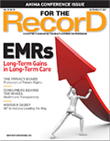September 17, 2007
 Coding for Cardiomyopathy
Coding for Cardiomyopathy
For The Record
Vol. 19 No. 19 P. 44
Cardiomyopathy is a progressive heart disease that impairs the hearts muscular walls. Although there are many possible causes of cardiomyopathy, such as coronary artery disease and valvular heart disease, the underlying cause is unknown.
Signs and Symptoms
The patient may not exhibit any signs and symptoms in the early stages of cardiomyopathy. As the disease progresses, patients may experience the following signs and symptoms:
• shortness of breath;
• swelling of lower extremities;
• abdominal distention due to fluid;
• fatigue;
• irregular heart rhythm; and
• dizziness, lightheadedness, and fainting.
Signs and symptoms will progress unless the condition is treated.
Types of Cardiomyopathy
The following are the three forms of cardiomyopathy:
• Dilated cardiomyopathy (ICD-9-CM code 425.4) is the most common form. The left ventricle becomes enlarged and loses strength to pump blood. When the cardiomyopathy is associated with alcoholism, assign code 425.5 for alcoholic cardiomyopathy. The most common type of dilated cardiomyopathy develops after a heart attack and is called ischemic cardiomyopathy (414.8). All ischemic cardiomyopathies are classified to code 414.8 (AHA Coding Clinic for ICD-9-CM, 1990, third quarter, page 15).
• Hypertrophic cardiomyopathy is an abnormal growth or thickening of the ventricle walls, causing a decrease in the amount of blood to the body. Code 425.4 is assigned for hypertrophic cardiomyopathy unless the condition is documented as obstructive, which is classified to code 425.1. Congenital hypertrophic obstructive cardiomyopathy is assigned to code 746.84.
• Restrictive cardiomyopathy (425.4) occurs when the ventricle walls become rigid or stiff and resist normal filling with blood between heartbeats.
Physicians may use the term congestive cardiomyopathy—also referred to as dilated cardiomyopathy—and is characterized by ventricular dilation, contractile dysfunction, and symptoms of congestive heart failure (CHF). When a patient presents with CHF and cardiomyopathy, treatment is typically focused on the CHF management. Therefore, sequence code 428.0 as the principal diagnosis, with code 425.4 added as a secondary diagnosis (AHA Coding Clinic for ICD-9-CM, 1990, second quarter, page 19).
Hypertensive cardiomyopathy is classified to codes 402.9x and 425.8. A fifth digit subclassification is required to identify the presence or absence of heart failure (AHA Coding Clinic for ICD-9-CM, 1993, second quarter, page 9)
Diagnosis
The physician may perform the following diagnostic tests if cardiomyopathy is suspected:
• chest x-ray to determine if the heart is enlarged;
• echocardiogram to view the size of the heart and the motion as it beats;
• cardiac catheterization to measure pressures within the heart chambers; and
• blood tests such as brain natriuretic peptide. This is a hormone produced in the heart that rises when the heart is subjected to the stress of CHF.
Treatment
Treatment will depend on the type of the cardiomyopathy. Dilated cardiomyopathy may be treated with the following medications:
• Angiotensin-converting enzyme inhibitor to improve the hearts pumping ability. Examples include enalapril (Vasotec), lisinopril (Zestril, Prinivil), ramipril (Altace), or captopril (Capoten).
• Diuretics to reduce fluid retention. A common diuretic includes furosemide (Lasix).
• Beta blockers to improve cardiac function. Common beta blockers include atenolol (Tenormin), carvedilol (Coreg), and metoprolol (Lopressor, Toprol XL).
Hypertrophic and restrictive cardiomyopathy may also be treated with medications such as beta blockers (Lopressor) and calcium channel blockers (Calan, Isoptin) to slow the heart pumping action and stabilize the heart rhythms.
The physician may also recommend inserting a biventricular pacemaker (00.50) for patients at risk for serious arrhythmias. If the cardiomyopathy has progressed to end stage, the patient will need a heart transplant (37.51).
Coding and sequencing for cardiomyopathy are dependent on the physician documentation in the medical record and application of the Official Coding Guidelines for inpatient care. Also, use specific AHA Coding Clinic for ICD-9-CM and American Medical Association CPT Assistant references to ensure complete and accurate coding.
— This information was prepared by Audrey Howard, RHIA, of 3M Consulting Services. 3M Consulting Services is a business of 3M Health Information Systems, a supplier of coding and classification systems to nearly 5,000 healthcare providers. The company and its representatives do not assume any responsibility for reimbursement decisions or claims denials made by providers or payers as the result of the misuse of this coding information. More information about 3M Health Information Systems is available at www.3mhis.com or by calling 800-367-2447.



